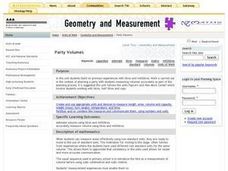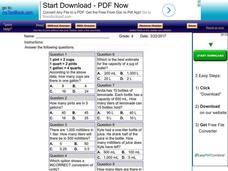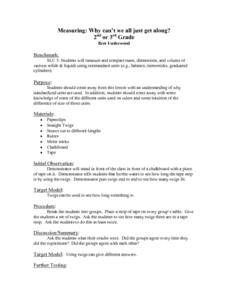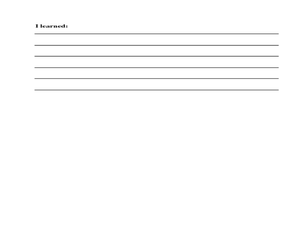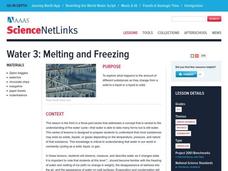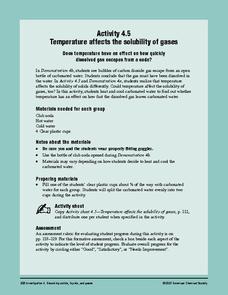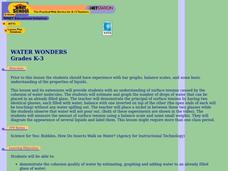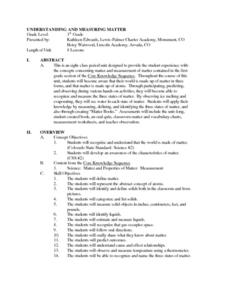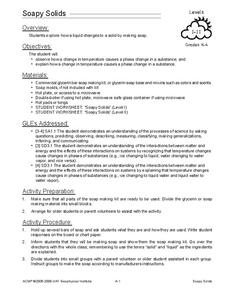Curated OER
Unknown Liquids
Learners must design and conduct an experiment to determine which unknown liquid has a greater density based on basic information about the liquids and containers. Students are given specific materials to work with.
Curated OER
Party Volumes: Measurement
Second graders explore liters and milliliters. They estimate volume and accurately measure the volume. Students plan a party and measure volume using liters and milliliters as part of the planning process.
Curated OER
Measurement
Fifth graders rename measurements with cups, pints, quarts, and gallons. In this measurements lesson plan, 5th graders pour different amounts of liquid that they transfer from cups to pints to quarts and to gallons. The then have to...
Curated OER
Measurement word problems
In this measurement learning exercise, students complete word problems having to do with measurement in the form of liquid measurement. Students complete 10 multiple choice problems.
Curated OER
Water and Ice
Students study the water cycle and the different forms of water. In this exploratory lesson plan students observe, measure and describe water as it changes state.
Curated OER
Water and Ice
Students observe water as it changes form. In this water activity students observe, measure, and describe water as it changes state.
Curated OER
Capillary Action
In this capillary action worksheet, students follow directions to see the ability of liquids being drawn up into small spaces using beakers, paper, rulers, food coloring and more. Students follow 8 sets of directions and write a...
Curated OER
Fractions and Measuring in Cooking
Sixth graders explore cooking by creating food in class. In this ingredient measurement activity, 6th graders discuss some of their favorite foods and review the proper recipes to cook them. Students utilize fractions to create a new...
Curated OER
Measuring: Why Can't We All Just Get Along?
Students examine why having standardized units of measurement is important. They investigate the use of non-standard measure, twigs, while measuring the piece of tape. Next, they experiment with straws, paper clips, and rulers before...
Curated OER
Density and Mass
Students experiment to find which liquids are more dense. In this density and mass instructional activity, students predict and then test objects to observe and measure their density. students observe which items sink and float....
Curated OER
Density Challenge
Young scholars calculate the densities of several liquids that appear similar. In this physical science instructional activity, students go beyond understanding the way liquids of different densities behave to researching how this...
Curated OER
Melting and Freezing
Students explore how various substances change from a solid to a liquid or from a liquid to a solid and how temperature, pressure and nature play an important role in this process. In this melting and freezing lesson,...
Curated OER
Addendum to the Written Curriculum: Measuring Solids
Students use standard rulers to measure the length of common classroom items - such as pencils, books, desk tops - in inches and centimeters, and measure weight in pounds. They also answer math questions, such as "How long is the front...
Curated OER
Measure Your Body
Students measure their bodies. In this math lesson plan, students record their height and weight. Students measure themselves in six months and observe any changes.
Curated OER
Units of Measure
For this metric units of measurement worksheet, students read information about estimating lengths and masses, then solve 65 problems. Sample problems with solutions are included.
American Chemical Society
Density of Water
We know solids have a density we can measure, but what about liquids? Lesson explores this concept and allows scholars to explore the relationship between volume and density. Graphing and analysis questions round out the activity.
American Chemical Society
Temperature Affects the Solubility of Gases
Dare your class to drive dissolved carbon dioxide out of carbonated liquid at different temperatures to discover if there is a difference in rate. To make this experiment more sound, have explorers use equally measured amounts of soda...
Alabama Learning Exchange
The Water Cycle
Learners identify the stages of the water cycle. They listen to the book "Magic School Bus: Wet All Over," examine the Build Your Own Water Cycle website, predict and measure the amount of water in a jar for a week, and read a short play...
Curated OER
Denser Sensor
Fourth graders calculate density, compare densities of solids and liquids, measure liquids using a balance, and investigate the significance of density. They conduct an experiment to determine an order of densities, and complete a...
Baylor College
We Need Water
There's nothing quite like a glass of ice-cold, freshly squeezed lemonade. Lesson seven of this series explains how the water humans need to survive can come in many forms. Teach your class about how much water humans require every day...
Curated OER
The Scientific Method
In this scientific method activity, students read over the basic steps of the scientific method and then apply those steps to a specific example. This activity has 8 short answer questions.
Curated OER
Water Wonders
Students experiment with the cohesion of water molecules. In this surface tension lesson, students estimate how many drops of water a full glass can take before overflowing. They watch a video that explains water molecules.
Curated OER
Understanding And Measuring Matter
First graders observe ice melting and water evaporating. They experiment with sugar and water and read the poem "Matter Really Matters." They define vocabulary words and sing a matter song.
Curated OER
Soapy Solids
Students observe and explain how a change in temperature causes a physical change in a substance. In this physical science instructional activity, students use a soap making kit to observe the effects of adding heat to the bar...
Other popular searches
- Measuring Liquids and Solids
- Metric Measuring Liquids
- Measuring Liquids in Math
- Measuring Liquids Lab
- Measuring Liquids and Masses



